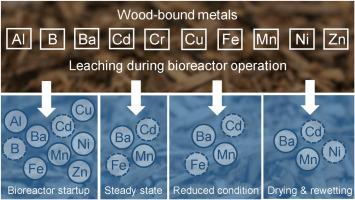当前位置:
X-MOL 学术
›
Aquacult. Eng.
›
论文详情
Our official English website, www.x-mol.net, welcomes your
feedback! (Note: you will need to create a separate account there.)
METAL LEACHING AND TOXICITY OF DENITRIFYING WOODCHIP BIOREACTOR OUTFLOW - POTENTIAL REUSE APPLICATION
Aquacultural Engineering ( IF 3.6 ) Pub Date : 2021-05-01 , DOI: 10.1016/j.aquaeng.2020.102129 Christine Lepine , Laura Christianson , David Soucek , Gregory McIsaac , Steven Summerfelt
Aquacultural Engineering ( IF 3.6 ) Pub Date : 2021-05-01 , DOI: 10.1016/j.aquaeng.2020.102129 Christine Lepine , Laura Christianson , David Soucek , Gregory McIsaac , Steven Summerfelt

|
Abstract The denitrifying woodchip bioreactor is designed to remediate nitrate-rich water, including those produced from aquaculture effluents. Reuse of treated bioreactor outflows in recirculating aquaculture would offer considerable water savings and valuable alkalinity recuperation. However, bioreactors may inadvertently leach detrimental wood-bound contaminants, preventing outflow reuse. To determine reuse potential, woodchip media from two hardwood species (white ash, Fraxinus Americana; Norway maple, Acer platanoides) were evaluated for 206 d under a range of operating conditions (start-up, steady-state, reducing conditions, and drying-rewetting cycles) for a spectrum of potentially harmful dissolved contaminants. Aerated outflows were also evaluated for acute and chronic toxicity to the biologically sensitive invertebrate Ceriodaphnia dubia. Dissolved metal leaching subsided within the first few weeks of operation, though initial concentrations of copper and zinc were detected at concentrations of concern. Elevated concentrations of tannins-lignin and total ammonia nitrogen were detected throughout the study and were influenced by operational phase. Acute toxicity was not generally detected, though chronic toxicity was observed during drying-rewetting cycles in the maple outflows. The measured toxicity was not correlated to water chemistry, indicating an additive effect of several toxicants. Overall, significant differences in outflow water quality between ash and maple wood species were negligible. Results indicated bioreactor outflows may be applicable for aquacultural reuse, though reusing outflows immediately following start-up or restarting after a dry period would not be recommended.
中文翻译:

反硝化木片生物反应器流出物的金属浸出和毒性 - 潜在的再利用应用
摘要 反硝化木片生物反应器旨在修复富含硝酸盐的水,包括水产养殖废水中产生的水。在循环水产养殖中重新使用处理过的生物反应器流出物将提供可观的节水和有价值的碱度恢复。然而,生物反应器可能会无意中浸出有害的木质污染物,从而阻止外流再利用。为确定再利用潜力,在一系列操作条件(启动、稳态、还原条件和干燥条件)下对来自两种硬木树种(白蜡、美洲白蜡;挪威枫、白桦)的木片介质进行了 206 天的评估。再润湿循环)用于一系列潜在有害的溶解污染物。还评估了曝气流出物对生物敏感无脊椎动物 Ceriodaphnia dubia 的急性和慢性毒性。溶解金属浸出在运行的最初几周内消退,尽管检测到铜和锌的初始浓度为令人担忧的浓度。在整个研究过程中检测到单宁-木质素和总氨氮浓度升高,并受操作阶段的影响。尽管在枫树流出物的干燥-再润湿循环期间观察到慢性毒性,但通常未检测到急性毒性。测得的毒性与水化学无关,表明几种毒物的叠加效应。总体而言,白蜡木和枫木树种之间出水水质的显着差异可以忽略不计。结果表明生物反应器流出物可能适用于水产养殖再利用,
更新日期:2021-05-01
中文翻译:

反硝化木片生物反应器流出物的金属浸出和毒性 - 潜在的再利用应用
摘要 反硝化木片生物反应器旨在修复富含硝酸盐的水,包括水产养殖废水中产生的水。在循环水产养殖中重新使用处理过的生物反应器流出物将提供可观的节水和有价值的碱度恢复。然而,生物反应器可能会无意中浸出有害的木质污染物,从而阻止外流再利用。为确定再利用潜力,在一系列操作条件(启动、稳态、还原条件和干燥条件)下对来自两种硬木树种(白蜡、美洲白蜡;挪威枫、白桦)的木片介质进行了 206 天的评估。再润湿循环)用于一系列潜在有害的溶解污染物。还评估了曝气流出物对生物敏感无脊椎动物 Ceriodaphnia dubia 的急性和慢性毒性。溶解金属浸出在运行的最初几周内消退,尽管检测到铜和锌的初始浓度为令人担忧的浓度。在整个研究过程中检测到单宁-木质素和总氨氮浓度升高,并受操作阶段的影响。尽管在枫树流出物的干燥-再润湿循环期间观察到慢性毒性,但通常未检测到急性毒性。测得的毒性与水化学无关,表明几种毒物的叠加效应。总体而言,白蜡木和枫木树种之间出水水质的显着差异可以忽略不计。结果表明生物反应器流出物可能适用于水产养殖再利用,









































 京公网安备 11010802027423号
京公网安备 11010802027423号